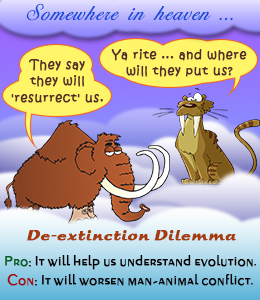
Can We Bring Back the Dinosaurs?
As of now, that seems like a distant dream, considering that it’s been too long since they became extinct, and their genetic material must have become irrecoverable as a result of fossilization.
The idea of watching extinct species like Tasmanian tigers and woolly mammoths roaming on the planet may seem far-fetched, but it is a dream the proponents of de-extinction cherish. With techniques like breeding back, genetic engineering, and cloning at their disposal, this dream has become very well a possibility. In breeding back, for instance, a living species which is genetically similar to the species to be resurrected is chosen and selectively bred for the latter’s traits.
Not everyone seems to be impressed though. While some people dismiss de-extinction as a futile exercise, others are worried about its ramifications. What the proponents consider a dream, is a nightmare for opponents. Most of the pros and cons of de-extinction revolve around its effects on the environment and ethical implications.
How Will De-extinction Help?
If we are able to resurrect species that have become extinct, especially the keystone species, we will also be able to revive ecosystems that have either been damaged or have disappeared. We will be able to use some of these species as flagship species to protect entire ecosystems. Simply put, de-extinction is the need of the hour, if we are to save the fast-depleting environment.
If we are able to pull of this feat, it will be a breakthrough in the field of genetic engineering. We will be able to understand what made these species vulnerable to extinction in the first place, and use the information to save related living species. We will also be able to eradicate diseases that are caused by specific genes by introducing immune species in the wild.
Most of our knowledge about evolution is based on theories. If we are able to bring back extinct species, we could get an insight into the evolution process.
On the morality front, we humans have been responsible for the extinction of a large number of species, including the Tasmanian tiger and Pyrenean ibex. If we are able to bring them back, it will help us undo the harm we have caused over the years―redemption of sorts.
And lastly, it will be worth the effort considering that we will be able to see these species, about whom we have only heard, roam the planet.
Why is De-extinction Not a Good Idea?
The foremost problem with de-extinction will be the lack of resources for the resurrected species. A species brought back from extinction will require a home (habitat) and food. The void these species left when they became extinct has already been filled by new species, and as such, a clash between the two groups will be inevitable. And not to forget, the problem of man-animal conflict will only become severe.
It’s difficult to guess how these species will be able to adapt to the environment. They might not be able to cope, or there are chances that they might become invasive, which, in turn, will put tremendous pressure on extant species as well as the ecosystem as a whole.
By bringing back these species, we might also bring back the viruses and pathogens that had become extinct with them, thus making a whole lot of extant species vulnerable. To make matters worse, we have no idea as to how these viruses and pathogens will affect us humans.
Humans are already exploiting extant species for their vested interests. What is the guarantee that resurrected species will not fall prey to human greed? We obviously don’t want to see gastric-brooding frogs and passenger pigeons in laboratories. There is no point in bringing species back from extinction if we cannot guarantee their safety. Saying we will guarantee it will be implausible, considering that millions of animals are already falling prey to animal testing every year. Like nuclear technology, even this technology in the wrong hands will only spell disaster; albeit, at a different level.
Then there is the issue of priorities, which we need to get right. There is no point in concentrating on de-extinction when millions of species are on the verge of extinction. Thus, it is far-fetched to say that de-extinction is a shot in the arm for the environment. If at all, it’s just a distraction from real issues. The huge amount of money that we are spending on de-extinction could be used to save species which are on the verge of extinction.
The belief that we need to work on saving endangered species will take a backseat, with the balance gradually shifting in favor of voices that say we can just save their DNA, and eventually use it to bring them back from extinction.
Speaking of ethics, the concept of de-extinction has also received flak for humans trying to play god. While atheists may not be interested in the creator argument, even they will agree that the concept is plain wrong because of the various unforeseen consequences associated with it.
De-extinction Species List
Like we said earlier, it’s difficult to bring back species that have been long gone, as the fossilization process makes their genetic material irrecoverable. Thus, only those species that have become extinct in the recent geological past are in contention for de-extinction. That’s not an issue, considering that the list of species we have lost in the last 100 years alone has some prominent names to its credit.
» Woolly mammoth» Passenger pigeon
» Tasmanian tiger» Pyrenean ibex
» Caribbean monk seal» Gastric-brooding frog
» Steller’s sea cow» Carolina parakeet
» Quagga» Dodo
» Aurochs» Hawaiian crow
The proponents of de-extinction are of the opinion that the concept will put things in place. The opponents, on the other hand, believe that this concept is nothing more than wishful thinking; even worse, a sham that is resulting in the waste of time and resources. The only silver lining in the cloud is that, the process will not start any time soon, which means we have ample time to think over it.
The question we need to ask is, whether we should bring back species from extinction just because we can; especially when there is a reason why they became extinct in the first place.











RSS